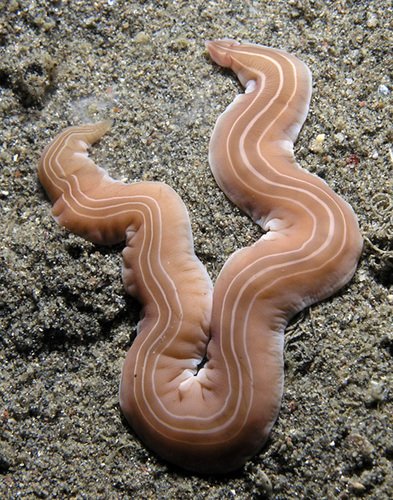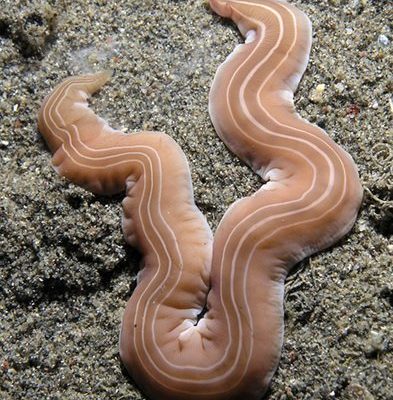
Now, if you’re not familiar with ribbon worms, let me paint you a picture: these slimy, elongated creatures can stretch up to several feet long and often come in vibrant hues. Think of them as the hidden artists of estuarine ecosystems, contributing quietly but significantly to the overall health and diversity of their surroundings. In this article, we’ll explore how ribbon worms play their part in the grand tapestry of life in estuaries.
What Are Ribbon Worms?
Ribbon worms, scientifically known as nemerteans, are soft-bodied invertebrates that belong to a group of animals that can be as long as 30 feet! They have a unique body structure that includes a long, stretchy proboscis, which they use to capture prey like small fish and crustaceans. Imagine them as nature’s little predators, lurking in the mud and sand at the bottom of the estuary, ready to snag a meal.
You might be wondering why these worms matter. Well, ribbon worms play a vital role in the ecosystem by serving as both predators and prey. They help keep populations of small organisms in check while also providing food for larger predators, like fish and birds. So, in essence, they help maintain the balance of the food web in estuarine environments.
Most ribbon worms are found buried in the sediments of estuaries, making them somewhat of a mystery. With over 1,000 species known to science, they thrive in a variety of habitats—from muddy shores to sandy bottoms. As we delve deeper, you’ll see how their presence affects biodiversity and contributes to the overall health of estuarine ecosystems.
Ribbon Worms and Nutrient Cycling
Let’s talk about how ribbon worms contribute to nutrient cycling. Think of nutrient cycling as nature’s way of recycling. In estuaries, plants absorb nutrients from the water and soil, and when those plants die or get eaten, the nutrients return to the ecosystem. Ribbon worms play a big part in this process.
When ribbon worms consume organic matter, they break it down and recycle essential nutrients back into the ecosystem. This helps to enrich the sediment and promotes growth among algae and other plant life, which is crucial for the entire estuarine community. More nutrients mean more food for a diverse range of organisms, from tiny phytoplankton to larger fish.
Moreover, as these worms move through the sediment, they help aerate it. This aeration is vital because it allows oxygen to seep into the soil, supporting even more life. So, you could say ribbon worms are like tiny bulldozers of biodiversity, constantly working to improve their environment.
Supporting Other Species
Ribbon worms also provide a food source for various estuarine animals. Larger fish, birds, and even some mammals rely on these worms as a nutritious meal. They’re particularly important in coastal regions where food may be scarce. Think of ribbon worms as the unsung heroes of the food chain.
By supporting other species, ribbon worms help maintain a diverse and balanced ecosystem. When an ecosystem has a variety of organisms, it’s more resilient to changes, like pollution or climate variations. A diverse population tends to thrive better than a homogenous one because it can adapt to challenges more easily.
If ribbon worms were to disappear, it could have a ripple effect, impacting the entire food web. This interconnectedness highlights how even the smallest organisms can make a significant difference in biodiversity.
Ribbon Worms and Habitat Structure
Another important role of ribbon worms lies in habitat structure. Their burrowing activities create tunnels in the sediment, which serve as microhabitats for other animals. Just picture those little worm-made highways in the mud; they provide safe spaces for smaller creatures to hide from predators.
These tunnels also allow water to circulate through the sediment, which helps maintain a healthy environment for organisms living there. It’s like creating a mini apartment complex that enhances the living conditions for various species.
This habitat structure becomes even more important in the changing climate, where estuarine environments face many challenges. Ribbon worms help build resilience in these areas by promoting complex habitats that can support a diverse array of life.
The Connection to Climate Change
With climate change putting pressure on estuarine environments, the role of ribbon worms becomes even more critical. Healthy ecosystems can better withstand stressors like rising temperatures and pollution. Ribbon worms contribute to this resilience by supporting biodiversity and nutrient cycling.
As estuaries face changes, ribbon worms might be one of the indicators of a healthy ecosystem. Changes in their populations could signal shifts in environmental conditions. By studying these worms, scientists gain insight into the overall health of estuaries.
Conservation efforts aimed at protecting ribbon worms can lead to wider benefits. When we take steps to preserve these small creatures, we’re also safeguarding the entire ecosystem. It’s a win-win situation for biodiversity and the health of our planet.
Conservation of Ribbon Worms
Protecting ribbon worms and their habitats is crucial for maintaining biodiversity in estuaries. Many factors threaten their populations, including pollution, habitat destruction, and climate change. Actions like reducing runoff, restoring habitats, and protecting estuarine areas can make a significant difference.
Local communities and conservation groups play a vital role in these efforts. Education initiatives raise awareness about the importance of ribbon worms and the ecosystems they inhabit. When people understand how these creatures fit into the larger picture, they’re more likely to support conservation efforts.
By fostering a sense of stewardship over estuarine environments, we can help ensure that ribbon worms and other vital organisms continue to thrive. After all, protecting these hidden gems means securing the future of biodiversity in our oceans and rivers.
Ribbon worms may not be the first organisms that come to mind when we think about biodiversity, but they are essential pieces of the puzzle. These fascinating creatures contribute to nutrient cycling, support other species, and create habitats, all while helping ecosystems remain resilient in the face of change.
As we continue to learn more about ribbon worms and their roles in estuarine environments, it’s clear that protecting them is fundamental to preserving the rich biodiversity of our planet. So next time you think about estuaries, remember the ribbon worms and the important work they do. After all, even the smallest creatures can have a big impact on the world around us.

